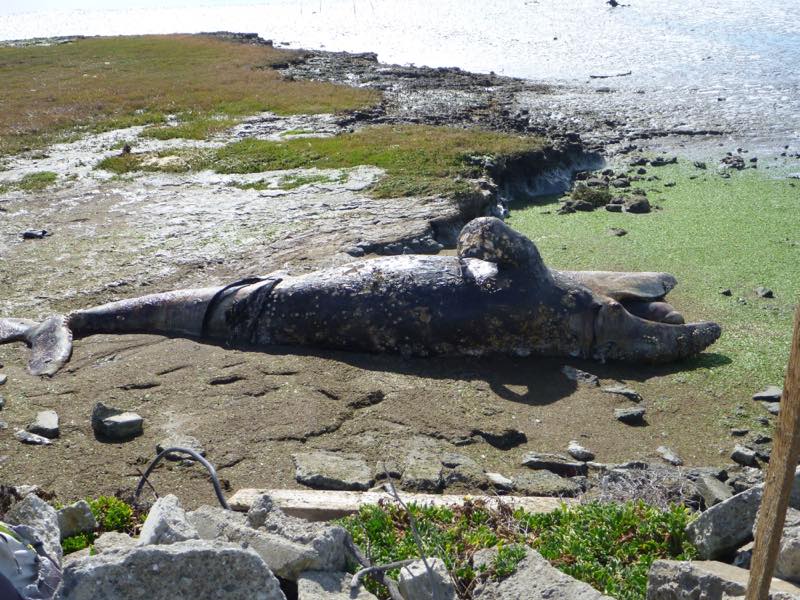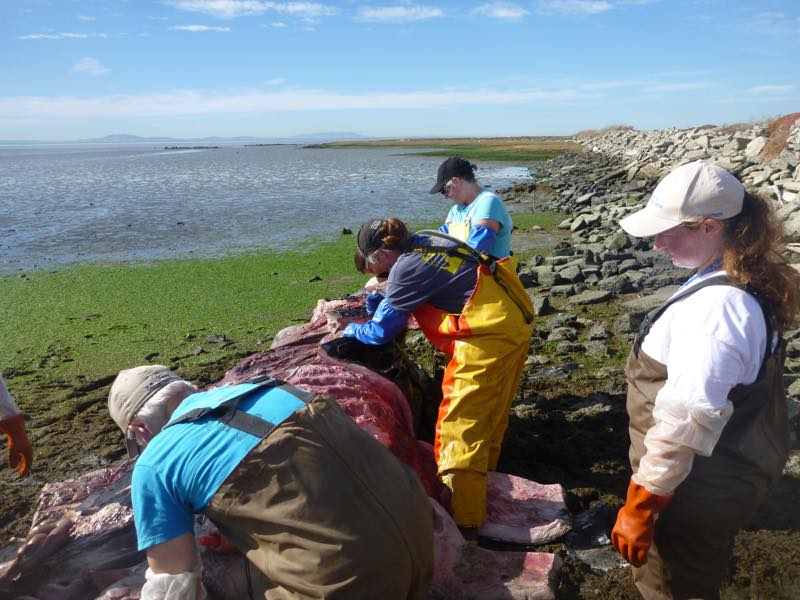
A gray whale carcass stranded along the shoreline at Coyote Hills Regional Park in Fremont, CA, on Thursday, September 24, 2015. Scientists from The Marine Mammal Center and California Academy of Sciences performed a necropsy to attempt to determine a cause of death. A final determination has not yet been made. Photo Credit Maureen Flannery © The Marine Mammal Center
On September 24, 2015, The Marine Mammal Center responded to a whale carcass that washed ashore south of the Alameda Creek Trail in the Coyote Hills Regional Park in Fremont, CA. The final report from the necropsy revealed propeller strike injuries to the dorsal area, consistent with a report of a ship strike earlier in September in the Oakland outer harbor channel.
The necropsy report noted that the wound from the ship strike only penetrated the blubber layer, and no hemorrhaging or broken bones were found by the strike area. The whale was emaciated and had a spine abnormality, limiting its ability to forage for food and making it potentially more susceptible to a vessel collision. A final determination of the cause of death is not yet known.
A team of six scientists from the Center along with four scientists from California Academy of Sciences performed the necropsy and collected samples the afternoon of September 24, 2015. The team confirmed that the carcass was a juvenile female gray whale, approximately 21 feet in length.

D. Barbie Halaska, research assistant with The Marine Mammal Center, says that every stranding represents an opportunity for scientists to learn more about the species and the ocean environment. Photo Credit Maureen Flannery © The Marine Mammal Center
“By conducting a necropsy on a whale that washes up on our shores, we’re able to expand our baseline data to better understand these marine mammals,” says Dr. Shawn Johnson, Director of Veterinary Science at The Marine Mammal Center. “Even when we are not able to determine a final cause of death, our research provides insights into the overall health of these animals and their ocean environment, including any human impacts that may play a role.”
NOAA recommends that all vessels of 300 gross registered tons or larger reduce speeds to a maximum of 10 knots per hour (approximately 11.5 mph) from May through November when whales gather to feed. The whales are protected under the federal Endangered Species Act, the Marine Mammal Protection Act and the National Marine Sanctuaries Act. The U.S. Coast Guard is currently broadcasting this speed reduction request in its Notice to All Mariners.
“By working with the maritime shipping industry, conservation groups, and others, we hope to minimize the outcomes of impacts from vessel-whale interactions,” said Maria Brown, superintendent of Greater Farallones National Marine Sanctuary. “At lower ship speeds whales are more likely to survive collisions.”

C. Scientists from The Marine Mammal Center and California Academy of Sciences assess a stranded gray whale at Coyote Hills Regional Park in Fremont, CA, on Thursday, September 24, 2015. Photo Credit Maureen Flannery © The Marine Mammal Center
In 2015, The Marine Mammal Center has responded to eight stranded whales, including:
- Pygmy sperm whale, Point Reyes National Seashore, CA, January 2015
o Cause of Death: Currently awaiting histology reports
- Sperm whale, Pacifica, CA, April 2015
o Cause of Death: Unknown
- Orca, Fort Bragg, CA, April 2015
o Cause of Death: Entanglement
- Humpback whale, Pacifica, CA, May 2015
o Cause of Death: Trauma consistent with ship strike injuries
- Gray whale, Sonoma, CA, May 2015
o Cause of Death: Unknown
- Humpback whale, Pacifica, CA, August 2015
o Cause of Death: Trauma consistent with ship strike injuries
- Fin whale, Alameda, CA, August 2015
o Cause of Death: Trauma due to vessel collision
- Gray whale, Fremont, CA, September 2015
o Cause of Death: Not yet determined
The Center has responded to 67 gray whales in its history. In May of this year, scientists from the Center responded to a gray whale carcass on Portuguese Beach near Bodega Bay in Sonoma County. Tissue samples were taken but a necropsy wasn’t completed due to the location of the carcass. The cause of death has yet to be determined.
In 2015, The Marine Mammal Center has responded to a record-breaking number of seals and sea lions, with over 1,600 rescued so far.
BACKGROUND:
Gray whales are one of the most frequently seen whales in California. They regularly migrate through coastal California waters and are visible by boat offshore. Gray whales are one of only two species to ever be removed from the Endangered Species List. The Eastern population found along the US and Canadian coast was delisted in 1994. Gray whales face the longest yearly migration of any whale at roughly 11,000 miles, traveling between Baja California and Alaska in a single trip.
“Every stranding represents an opportunity for us to learn more about this species and our ocean environment,” says Barbie Halaska, of The Marine Mammal Center. “There tend to be peaks in whale strandings in the spring and fall, aligned with the migration and calving season.”
How the public can help:
• Report sick and injured marine mammals to The Marine Mammal Center by calling 415-289-SEAL (7325).
• Maintain a safe distance of at least 50 feet from marine mammals and keep dogs away.
• The Marine Mammal Center is a nonprofit facility and depends on donations from members of the public to respond to and care for animals such as this stranded whale.
Visit https://www.MarineMammalCenter.org/donate to help the Center perform its life-saving work.
About The Marine Mammal Center:
Founded in 1975 out of compassion for stranded seals and sea lions, The Marine Mammal Center has evolved into the world’s largest marine mammal rehabilitation hospital. In addition to the rescue of marine mammals, this nonprofit organization is internationally acclaimed for its scientific research and educational programs. As a true teaching hospital, the Center hosts veterinarians from around the world who come to train and gives schoolchildren the opportunity to slip into the mindset of marine biologists, developing a passion for the ocean environment and its protection.
